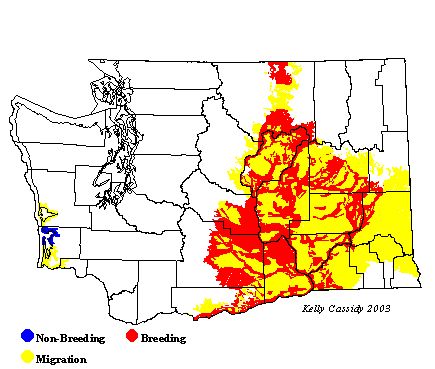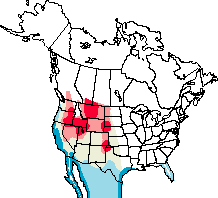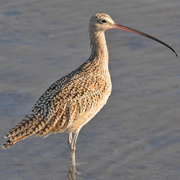Long-billed Curlew
General Description
The Long-billed Curlew is the largest North American shorebird. It has a very long, decurved bill, which is longer on adult females than on males and juveniles. It is mottled brown overall, with cinnamon underwings. Sometimes a striped head pattern is evident, but it is far less pronounced than the head stripes on the Whimbrel. It is similar in size, shape, and color to the Marbled Godwit, but the curlew's decurved bill distinguishes it from the upturned bill of the Marbled Godwit.
Habitat
Dry grasslands and shrub savannahs are the traditional breeding habitats of Long-billed Curlews. They also nest in grain fields and pastures. During migration and winter, they can be found on coastal mudflats and marshes, and less commonly in fields and grasslands.
Behavior
These birds often gather in small flocks and forage by walking quickly along with their long bills extended forward, probing for food.
Diet
In summer, earthworms and other invertebrates are common prey. Berries may also be important food at certain times of the year. Birds in coastal areas eat crabs and other aquatic creatures.
Nesting
Males attract females and defend their territories with undulating flight displays, fluttering and gliding while calling. The nest is on the ground in the open, but is often located next to an object such a rock, a shrub, or even a pile of cow manure. The nest itself is a shallow scrape, usually sparsely lined with vegetation, sometimes with a rim built up around the edge. Both parents help incubate the four eggs for 27-30 days. The young leave the nest shortly after hatching and feed themselves, although both parents tend them and lead them to a marshy or damp area to find food. The young begin to fly at 32-45 days.
Migration Status
This short-distance migrant is one of the earliest breeding shorebirds, returning from wintering grounds from California to Mexico in mid-March, before their nesting grounds dry out. The adults leave by mid-July, with the young of the year leaving in mid-August.
Conservation Status
Once abundant, Long-billed Curlews declined as a result of hunting in the 1800s. Protection has helped the birds rebound, and now habitat destruction is their biggest threat. As more and more native grassland is converted to agriculture, the amount of potential Long-billed Curlew nesting habitat is shrinking. The Canadian Wildlife Service estimates the current population at about 20,000 birds.
When and Where to Find in Washington
Long-billed Curlews breed in eastern Washington in the central Columbia Basin and up through the Okanogan Valley. They are uncommon throughout the state during migration. They generally winter south of Washington, but a flock winters around Tokeland at Willapa Bay (Pacific County) every winter. Bill's Spit at Ocean Shores is another place to look for them.
 Abundance
Abundance
| Ecoregion | Jan | Feb | Mar | Apr | May | Jun | Jul | Aug | Sep | Oct | Nov | Dec |
|---|---|---|---|---|---|---|---|---|---|---|---|---|
| Oceanic | ||||||||||||
| Pacific Northwest Coast | U | U | U | R | R | U | U | U | U | U | U | |
| Puget Trough | ||||||||||||
| North Cascades | ||||||||||||
| West Cascades | ||||||||||||
| East Cascades | ||||||||||||
| Okanogan | R | U | U | U | U | |||||||
| Canadian Rockies | ||||||||||||
| Blue Mountains | ||||||||||||
| Columbia Plateau | U | U | U | U | U | R |
Washington Range Map

North American Range Map


Family Members
 Spotted SandpiperActitis macularius
Spotted SandpiperActitis macularius Solitary SandpiperTringa solitaria
Solitary SandpiperTringa solitaria Gray-tailed TattlerTringa brevipes
Gray-tailed TattlerTringa brevipes Wandering TattlerTringa incana
Wandering TattlerTringa incana Greater YellowlegsTringa melanoleuca
Greater YellowlegsTringa melanoleuca WilletTringa semipalmata
WilletTringa semipalmata Lesser YellowlegsTringa flavipes
Lesser YellowlegsTringa flavipes Upland SandpiperBartramia longicauda
Upland SandpiperBartramia longicauda Little CurlewNumenius minutus
Little CurlewNumenius minutus WhimbrelNumenius phaeopus
WhimbrelNumenius phaeopus Bristle-thighed CurlewNumenius tahitiensis
Bristle-thighed CurlewNumenius tahitiensis Long-billed CurlewNumenius americanus
Long-billed CurlewNumenius americanus Hudsonian GodwitLimosa haemastica
Hudsonian GodwitLimosa haemastica Bar-tailed GodwitLimosa lapponica
Bar-tailed GodwitLimosa lapponica Marbled GodwitLimosa fedoa
Marbled GodwitLimosa fedoa Ruddy TurnstoneArenaria interpres
Ruddy TurnstoneArenaria interpres Black TurnstoneArenaria melanocephala
Black TurnstoneArenaria melanocephala SurfbirdAphriza virgata
SurfbirdAphriza virgata Great KnotCalidris tenuirostris
Great KnotCalidris tenuirostris Red KnotCalidris canutus
Red KnotCalidris canutus SanderlingCalidris alba
SanderlingCalidris alba Semipalmated SandpiperCalidris pusilla
Semipalmated SandpiperCalidris pusilla Western SandpiperCalidris mauri
Western SandpiperCalidris mauri Red-necked StintCalidris ruficollis
Red-necked StintCalidris ruficollis Little StintCalidris minuta
Little StintCalidris minuta Temminck's StintCalidris temminckii
Temminck's StintCalidris temminckii Least SandpiperCalidris minutilla
Least SandpiperCalidris minutilla White-rumped SandpiperCalidris fuscicollis
White-rumped SandpiperCalidris fuscicollis Baird's SandpiperCalidris bairdii
Baird's SandpiperCalidris bairdii Pectoral SandpiperCalidris melanotos
Pectoral SandpiperCalidris melanotos Sharp-tailed SandpiperCalidris acuminata
Sharp-tailed SandpiperCalidris acuminata Rock SandpiperCalidris ptilocnemis
Rock SandpiperCalidris ptilocnemis DunlinCalidris alpina
DunlinCalidris alpina Curlew SandpiperCalidris ferruginea
Curlew SandpiperCalidris ferruginea Stilt SandpiperCalidris himantopus
Stilt SandpiperCalidris himantopus Buff-breasted SandpiperTryngites subruficollis
Buff-breasted SandpiperTryngites subruficollis RuffPhilomachus pugnax
RuffPhilomachus pugnax Short-billed DowitcherLimnodromus griseus
Short-billed DowitcherLimnodromus griseus Long-billed DowitcherLimnodromus scolopaceus
Long-billed DowitcherLimnodromus scolopaceus Jack SnipeLymnocryptes minimus
Jack SnipeLymnocryptes minimus Wilson's SnipeGallinago delicata
Wilson's SnipeGallinago delicata Wilson's PhalaropePhalaropus tricolor
Wilson's PhalaropePhalaropus tricolor Red-necked PhalaropePhalaropus lobatus
Red-necked PhalaropePhalaropus lobatus Red PhalaropePhalaropus fulicarius
Red PhalaropePhalaropus fulicarius

